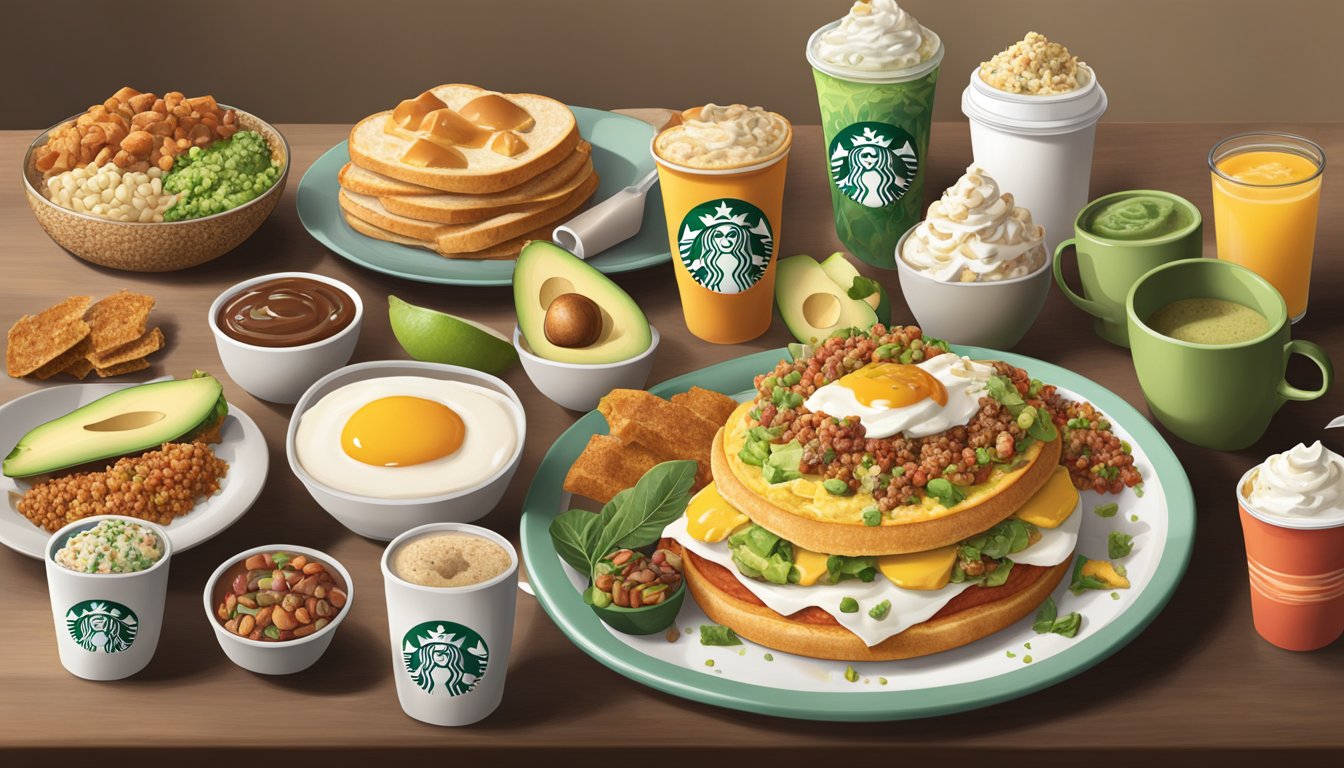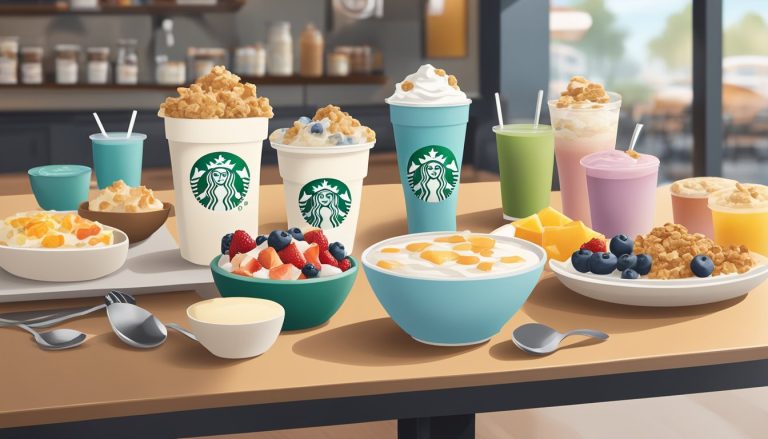Starbucks has become a go-to spot for millions seeking their morning caffeine fix and a quick breakfast. While many customers are familiar with the coffee giant’s menu, the ingredients in some of their breakfast items might come as a surprise.
From unexpected spices to unique protein sources, Starbucks incorporates a variety of intriguing components into their breakfast offerings. This article explores ten of the most surprising ingredients found in Starbucks breakfast items, shedding light on the complex flavors and nutritional profiles that make up these popular morning meals.
1) Ancho Chile Butter

Starbucks surprised customers by introducing ancho chile butter in select breakfast items. This unique ingredient adds a subtle smoky heat to sandwiches and wraps.
Ancho chiles are dried poblano peppers with a mild, sweet flavor and a hint of spice. When blended into butter, they create a rich, complex spread that elevates simple breakfast fare.
The ancho chile butter appears in Starbucks’ Southwest-inspired offerings. It pairs particularly well with egg-based items, adding depth and warmth without overpowering other flavors.
This ingredient demonstrates Starbucks’ commitment to incorporating diverse flavors into their menu. By using ancho chiles, the coffee chain taps into Mexican culinary traditions and brings them to a wider audience.
The mild heat of ancho chile butter appeals to customers seeking a more adventurous breakfast option. It provides just enough spice to wake up taste buds without being too intense for morning consumption.
2) Sriracha Infusion

Starbucks surprised customers by incorporating sriracha into select breakfast items. This spicy sauce, traditionally associated with Asian cuisine, has found its way into the coffee giant’s morning offerings.
Starbucks created their own version of sriracha to add heat to menu items. The sauce blends jalapeño puree, garlic, red bell pepper puree, and white vinegar, among other ingredients.
In 2022, Starbucks introduced Sriracha Cold Foam, a spicy addition to lattes, cappuccinos, cold brews, and refreshers. This innovative topping combines nonfat milk, vanilla syrup, and sriracha for a tangy kick.
The following year, Starbucks launched its first sriracha entrée: the Sriracha Chicken Wrap. This breakfast item features shredded chicken, peppers, spinach, and sriracha sauce wrapped in a tomato-basil tortilla.
By infusing sriracha into breakfast items, Starbucks caters to customers seeking bolder flavors in their morning meals. This unexpected ingredient demonstrates the company’s willingness to experiment with diverse taste profiles.
3) Spelt Flour

Spelt flour is an unexpected ingredient in some Starbucks breakfast items. This ancient grain has gained popularity in recent years due to its nutty flavor and potential health benefits.
Starbucks incorporates spelt flour into select baked goods to cater to customers seeking alternatives to traditional wheat flour. The use of spelt adds a unique taste and texture to certain breakfast pastries.
Spelt flour contains less gluten than regular wheat flour, which can result in a denser texture in baked products. This characteristic may contribute to a heartier feel in some Starbucks breakfast items.
The inclusion of spelt flour aligns with Starbucks’ efforts to offer diverse options for various dietary preferences. It provides a subtle twist to familiar breakfast favorites while maintaining the expected quality.
Customers might be surprised to learn that this ancient grain is part of their morning routine at Starbucks. The use of spelt flour demonstrates the company’s commitment to exploring innovative ingredients in their breakfast menu.
4) Pepita Seeds

Pepita seeds are a surprising ingredient found atop Starbucks’ popular Pumpkin & Pepita Loaf. These small, green seeds are actually the edible kernels of pumpkin seeds, stripped of their white outer hulls.
Pepitas add a delightful crunch and nutty flavor to the sweet pumpkin bread. They’re not just for taste and texture, though. Pepitas are packed with nutrients, including protein, healthy fats, and minerals like zinc and iron.
Starbucks uses pepitas that have been lightly roasted and salted, enhancing their flavor profile. This subtle seasoning complements the warm spices in the pumpkin loaf, creating a balanced taste experience.
Many customers mistake pepitas for nuts due to their crunchy texture and nutty flavor. However, they’re actually seeds, making them a suitable option for those with nut allergies.
The inclusion of pepitas on this breakfast item showcases Starbucks’ attention to detail in creating interesting flavor combinations. It’s a simple yet effective way to elevate a classic pumpkin bread recipe.
5) Turmeric Latte Mix

Starbucks surprised customers with the introduction of its Golden Turmeric Latte Mix. This unique blend combines turmeric, ginger, cinnamon, and black pepper to create a flavorful and aromatic beverage.
The mix offers a twist on traditional coffee drinks, appealing to health-conscious consumers seeking alternatives to caffeine-heavy options. Turmeric, known for its potential anti-inflammatory properties, takes center stage in this innovative concoction.
Starbucks developed this recipe for home preparation, allowing customers to enjoy the exotic flavors without visiting a store. The mix pairs well with various milk options, catering to different dietary preferences.
While not available in Starbucks cafes, the Golden Turmeric Latte Mix exemplifies the company’s efforts to expand its product range and adapt to changing consumer tastes. The inclusion of spices like ginger and black pepper enhances the warming qualities of the drink.
This product demonstrates Starbucks’ willingness to explore non-traditional ingredients and flavor combinations in its breakfast offerings. The Golden Turmeric Latte Mix provides a unique option for those seeking a spicy, comforting start to their day.
6) Hemp Seed Topping

Starbucks has embraced a surprising ingredient in some of its breakfast offerings: hemp seeds. These tiny seeds pack a nutritional punch, offering a rich source of protein, omega-3 fatty acids, and various minerals.
Hemp seeds have a mild, nutty flavor that complements many breakfast items. They can be found sprinkled on top of certain oatmeal dishes and breakfast bowls at select Starbucks locations.
Despite being derived from the same plant species as marijuana, hemp seeds contain negligible amounts of THC. They are perfectly legal and safe for consumption, adding a unique twist to Starbucks’ menu.
The inclusion of hemp seeds aligns with Starbucks’ efforts to cater to health-conscious customers. These seeds provide a plant-based protein boost and contribute to a more diverse nutrient profile in breakfast options.
By incorporating hemp seeds, Starbucks demonstrates its willingness to experiment with trendy superfoods. This addition sets their breakfast menu apart from traditional coffee shop fare.
7) Quinoa Breakfast Bowl

Starbucks surprised customers by introducing quinoa into their breakfast menu. This protein-packed seed, often mistaken for a grain, adds a nutritious twist to the morning lineup.
The Quinoa Breakfast Bowl offers a hearty alternative to traditional oatmeal. It combines fluffy quinoa with a mix of fresh fruits, nuts, and a drizzle of honey for sweetness.
Quinoa’s mild, nutty flavor complements the other ingredients while providing essential amino acids and fiber. This unexpected addition caters to health-conscious customers seeking a filling, plant-based option.
The inclusion of quinoa reflects Starbucks’ efforts to diversify their menu and appeal to evolving dietary preferences. It demonstrates the coffee giant’s willingness to embrace trendy superfoods.
While not as common as oats or granola in breakfast bowls, quinoa’s presence showcases Starbucks’ innovative approach to morning fare. This ingredient choice aligns with current health and wellness trends.
8) Matcha Latte Powder

Starbucks’ Matcha Latte Powder contains an unexpected ingredient: sugar. Unlike traditional matcha, which is pure ground green tea leaves, Starbucks uses a pre-sweetened blend.
This mixture combines matcha powder with sugar, creating a more palatable taste for the average consumer. The addition of sugar significantly alters the nutritional profile of the drink.
A single serving of Starbucks’ matcha powder contains approximately 32 grams of sugar. This amount is higher than what many people might expect from a tea-based beverage.
The sweetened matcha blend allows Starbucks to create consistent flavors across their locations. It also caters to the American palate, which often prefers sweeter tastes.
Recently, Starbucks has made changes to their matcha offerings. They now provide options for customers to customize the sweetness level of their matcha drinks.
This move gives patrons more control over their beverage’s sugar content. It also allows those seeking a more traditional matcha experience to reduce the added sweetness.
9) Coconut Milk Foam

Starbucks introduced coconut milk foam as a dairy-free alternative for customers seeking plant-based options. This surprising ingredient adds a creamy texture to various beverages without using traditional milk products.
The coconut milk used by Starbucks contains a blend of coconut cream, water, and other additives. These additives help create a stable foam that holds its shape in hot and cold drinks.
Starbucks’ coconut milk foam contains 17 grams of sugar and 180 calories per 16-ounce serving. This makes it a relatively high-calorie option compared to some other milk alternatives.
The foam’s unique composition allows baristas to create intricate latte art and add a luxurious touch to specialty drinks. It has become particularly popular in iced beverages and refreshers.
Customers can request coconut milk foam as a customization for many drinks on the Starbucks menu. This versatility has made it a favorite among those with dairy allergies or dietary preferences.
10) Brown Rice Syrup

Brown rice syrup is an unexpected ingredient in some Starbucks breakfast offerings. This natural sweetener is derived from brown rice that has been cooked and exposed to enzymes, breaking down the starches into sugars.
Starbucks uses brown rice syrup in select items as a healthier alternative to refined sugars. It provides a subtle sweetness and can help bind ingredients together in bars and snacks.
The syrup has a lower glycemic index compared to regular sugar, potentially leading to more stable blood sugar levels. It also contains trace amounts of nutrients like magnesium and manganese.
Customers may find brown rice syrup listed in the ingredients of certain Starbucks fruit and nut bars or oatmeal toppings. Its inclusion aligns with the company’s efforts to offer more natural and health-conscious options.
While brown rice syrup adds a unique flavor profile, it’s important to note that it’s still a form of added sugar. Starbucks uses it judiciously to balance taste and nutritional value in their breakfast items.
Nutritional Insights

Starbucks breakfast items contain surprising ingredients that impact their nutritional value. Some offer health benefits, while others may pose concerns for those with allergies or dietary restrictions.
Health Benefits
Starbucks’ Rolled & Steel Cut Oatmeal provides 410 calories, 12 grams of fat, 7 grams of fiber, and 8 grams of protein. The fiber content helps lower cholesterol and promotes satiety. Many breakfast options at Starbucks are protein-rich, supporting muscle health and prolonged fullness.
The Spinach, Feta, and Egg White Wrap is a nutritious choice with 230 calories, 5 grams of fat, and 17 grams of protein. It offers a balanced mix of macronutrients without excessive calories or sugar.
Some breakfast items include dried fruits and nuts, providing essential vitamins, minerals, and healthy fats. These ingredients enhance the nutritional profile of meals while adding flavor and texture.
Allergen Information
Starbucks offers a Certified Gluten-Free Breakfast Sandwich for customers with gluten sensitivities. This option contains 320 calories, 13 grams of fat, and 18 grams of protein, making it suitable for those following a gluten-free diet.
Many Starbucks breakfast items contain common allergens such as eggs, dairy, and wheat. The company provides detailed allergen information for each product on their website and in-store upon request.
Customers with nut allergies should be cautious, as several breakfast options contain nuts or may be prepared in facilities that process nuts. Cross-contamination risks exist in the preparation areas.
Soy and dairy alternatives are available for most beverages, catering to those with lactose intolerance or milk allergies. These substitutions may alter the nutritional content of drinks.
Ingredient Origins
Starbucks carefully selects ingredients from various sources worldwide, focusing on quality and sustainability. The company prioritizes responsible sourcing practices and implements initiatives to reduce environmental impact.
Sourcing Practices
Starbucks partners with farmers and suppliers globally to obtain high-quality ingredients. Coffee beans come from Latin America, Africa, and Asia-Pacific regions. The company works directly with coffee growers through its Coffee and Farmer Equity (C.A.F.E.) Practices program.
For dairy products, Starbucks sources milk from local farms near its stores when possible. This helps support local economies and reduces transportation distances.
Baked goods often use flour from North American wheat farms. Fruits and vegetables are sourced seasonally from various regions to ensure freshness and flavor.
Sustainability Efforts
Starbucks has committed to ethical sourcing and environmental stewardship. The company aims to make coffee the world’s first sustainably sourced agricultural product.
Starbucks invests in farmer support centers to provide resources and training on sustainable farming practices. These efforts help improve crop yields and quality while reducing environmental impact.
The company also focuses on reducing waste in its supply chain. Starbucks has implemented recycling programs and is working towards developing more eco-friendly packaging solutions.
By 2025, Starbucks plans to reduce water usage in its agricultural supply chain by 50%. The company is also investing in reforestation projects to offset its carbon footprint.




